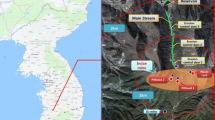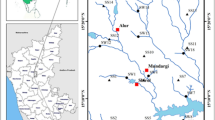Abstract
Arsenic (As) is among the most harmful toxic elements to human health with severe carcinogenic and non-carcinogenic effects. The present study aims to (1) characterize a site with geogenic As anomaly (Emet basin) in Kutahya, Turkey via soil (urban, agriculture, forest; n = 53 total), water (n = 11), and agricultural product (n = 19) samples; and, (2) characterize human health risks for different receptors under specific exposure scenarios. Soil As levels were very high (range, 22.4–765 mg kg−1). Previous literature suggested some evidence of Sb and Hg combined with As in mineral forms in the region; the present study found elevated Sb (up to 76.0 mg kg−1) in two regions with very high As levels, but Hg concentrations were low in the region. Soils from urban/agricultural zones (representing anthropogenic impact) did not have statistically different As levels compared with forest soils (representing low/no human impact). As water concentrations were also very high (range, 14.0–729 μg L−1), however, uptake by agricultural products was low, mostly limited to wheat (up to 0.7 mg kg−1). Exposure assessment/risk characterization showed that non-carcinogenic risk following exposure to soils was very high for children (hazard index up to 37 under reasonable maximum exposure) as well as carcinogenic risk (probability up to 1.19E−3). The risk was even higher considering intake of water, and in this case, both for children and adults (HI, 4.0–66.6; cancer risk, 1.29E−4–1.84E−2). The potential adverse outcomes of the As anomaly in the region may be grave, thus further geochemical investigation of As speciation and mobile fractions as well as gastrointestinal As bioaccessibility supplementing probabilistic human health risk characterization are recommended.


Similar content being viewed by others
References
Abernathy, C. O., Calderon, R. L., Chappell, W. R. (1997). Arsenic—exposure and health effects. Chapman & Hall, 1st ed., Dordrecht, Netherlands: Springer Science+Business Media B.V.
Akdeniz, N., Konak, N. (1979). Simav–Emet–Dursunbey–Demirci Yörelerinin Jeolojisi, General Directorate of the Mineral Research & Exploration of Turkey, Compilation Report No. 6547 (in Turkish), Ankara, Turkey.
American Society for Testing and Materials (ASTM). (2013). Standard test method for pH of soils—method D4972-13. West Conshohocken: ASTM International.
Banerjee, M., Banerjee, N., Bhattacharjee, P., Mondal, D., Lythgoe, P. R., Martínez, M., Pan, J., & Polya, D. A. (2013). High arsenic in rice is associated with elevated genotoxic effects in humans. Scientific Reports-UK, 3(2195), 1–8.
Brannon, J. M., & Patrick, W. H. (1987). Fixation, transformation, and mobilization of arsenic in sediments. Environmental Science & Technology, 21, 450–459.
Canadian Council of Ministers of the Environment (CCME) (2001). Canadian environmental quality guidelines, CCME Documents c/o Manitoba Statutory Publications, Winnipeg, MB, Canada.
Davis, S., Myers, P. A., Kohler, E., & Wiggins, C. (1995). Soil ingestion in children with pica: Final report, U.S. EPA cooperative agreement CR 816334-01. Seattle: Fred Hutchinson Cancer Research Center.
Di Benedetto, F., Costagliola, P., Benvenuti, M., Lattanzi, P., Romanelli, M., & Tanelli, G. (2006). Arsenic incorporation in natural calcite lattice. Evidence from electron spin echo spectroscopy. Earth and Planetary Science Letters, 246, 458–465.
Dietrich, S., Bea, S., Weinzettel, P., Torres, E., & Ayora, C. (2016). Occurrence and distribution of arsenic in the sediments of a carbonate-rich unsaturated zone. Environment and Earth Science, 75, 1–14.
Dogan, M., & Dogan, A. U. (2007). Arsenic mineralization, source, distribution, and abundance in the Kutahya region of the western Anatolia, Turkey. Environmental Geochemistry and Health, 29, 119–129.
Dogan, M., Dogan, A. U., Celebi, C., & Baris, Y. I. (2005). Geogenic arsenic and a survey of skin lesions in the Emet Region of Kutahya, Turkey. Indoor and Built Environment, 14(6), 533–536.
Dundar A., Gungor N., Gursel T., Ozden M., Ozyegin E. (1986). Kutahya – Emet bor tuzu yatagı nihai degerlendirme raporu, General Directorate of the Mineral Research & Exploration of Turkey, Evaluation Report (in Turkish), Ankara, Turkey.
Freire, A. R., Aragon, M. S., Bernard, I. O., & Peinado, F. J. M. (2014). Toxicity of arsenic in relation to soil properties: Implications to regulatory purposes. Journal of Soils and Sediments, 14, 68–979.
Goldberg, S., & Glaubig, R. A. (1988). Anion sorption on a calcareous, montmorilloniticsoil-arsenic. Soil Science Society of America Journal, 52, 1297–1300.
Gomez, J. J., Lillo, J., & Sahun, B. (2006). Naturally occurring arsenic in groundwater and identification of the geochemical sources in the Duero Cenozoic Basin, Spain. Environmental Geology, 50(8), 1151–1170.
Goyer, R. A., Clarkson, T. W. (1996). Essentials of toxicology: Toxic effects of metals, chapter 23, McGraww-Hill.
Guney, M., & Zagury, G. J. (2016). Bioaccessibility and other key parameters in assessing oral exposure to PAH-contaminated soils and dust: A critical review. Human and Ecological Risk Assessment, 22(6), 1396–1417.
Guney, M., Zagury, G. J., Dogan, N., & Onay, T. T. (2010). Exposure assessment and risk characterization from trace elements following soil ingestion by children exposed to playgrounds, parks and picnic areas. Journal of Hazardous Materials, 182, 656–664.
Helvaci, C., & Alonso, N. R. (2010). Borate deposits of Turkey and Argentina, A summary and Geological Comparison. Turkish Journal of Earth Sciences, 9, 1–27.
Hughes, M. F., Beck, B. D., Chen, Y., Lewis, A. S., & Thomas, D. J. (2011). Arsenic exposure and toxicology: A historical perspective. Toxicological Sciences, 123, 305–332.
Jiang, J. Q., Ashekuzzaman, S. M., Jiang, A., Sharifuzzaman, S. M., & Chowdhury, S. R. (2013). Arsenic contaminated groundwater and its treatment options in Bangladesh. International Journal of Environmental Research and Public Health, 10(1), 18–46.
Joseph, T., Dubey, B., & McBean, E. A. (2015). Human health risk assessment from arsenic exposures in Bangladesh. Science of the Total Environment, 527-528, 552–560.
Kabata-Pendias, A., & Pendias, H. (2001). Trace elements in soils and plants (3rd ed.). Boca-Raton: CRC Press LLC.
Kim, K. W., Bang, S., Zhu, Y., Meharg, A. A., & Bhattacharya, P. (2009). Arsenic geochemistry, transport mechanism in the soil-plant system, human and animal health issues. Environment International, 35, 453–454.
Matschullat, J. (2000). Arsenic in the geosphere—A review. Science of the Total Environment, 249, 297–312.
Ministère du Developpement durable, Environnement et Lutte contre les Changements Climatiques du Québec (MDDELCC) (2019). Annex 2: Tableau 1: Politique de protection des sols et de réhabilitation des terrains contaminés. Accessed on: 1 June 2019. http://www.environnement.gouv.qc.ca/sol/terrains/guide-intervention/annexe2.pdf.
Missimer, T. M., Teaf, C. M., Beeson, W. T., Maliva, R. G., Woolschlager, J., & Covert, D. J. (2018). Natural background and anthropogenic arsenic enrichment in Florida soils, surface water, and groundwater: A review with a discussion on public health risk. International Journal of Environmental Research and Public Health, 15, 2278.
Mukherjee, A., Sengupta, M. K., Hossain, M. A., Ahamed, S., Das, B., Nayak, B., et al. (2006). Health Popul. Nutr., 24(2), 142–163.
Ozkul, C., Tokel, S., & Savas, M. (2011). Emet (Kutahya) Neojen havzasi topraklarinda saptanan jeojenik arsenik ve antimon anomalileri. Dumlupınar Üniversitesi Fen Bilimleri Enstitüsü Dergisi (scientific article in Turkish), 25.
Ozkul, C., Çiftçi, E., Köprübaşı, N., Tokel, S., & Savaş, M. (2015). Geogenic arsenic anomalies in soils and stream waters of Neogene Emet basin (Kutahya-Western Turkey). Environment and Earth Science, 73, 6117–6130.
Ozkul, C., Çiftçi, E., Tokel, S., & Savaş, M. (2017). Boron as an exploration tool for terrestrial borate deposits: A soil geochemical study in Neogene Emet-Hisarcik basin where the world largest borate deposits occur (Kutahya-western Turkey). Journal of Geochemical Exploration, 173, 31–51.
Rasool, A., Farooqi, A., Masood, S., & Hussain, K. (2016). Arsenic in groundwater and its health risk assessment in drinking water of Mailsi, Punjab, Pakistan. Human and Ecological Risk Assessment, 22(1), 187–202.
Roman-Ross, G., Cuello, G. J., Turrillas, X., Fernandez-Martinez, A., & Charlet, L. (2006). Arsenite sorption and co-precipitation with calcite. Chemical Geology, 233, 328–336.
Romero, F. M., Armienta, M. A., & Carrillo-Chavez, A. (2004). Arsenic sorption by carbonate-rich aquifer material, a control on arsenic mobility at Zimapan, Mexico. Archives of Environmental Contamination and Toxicology, 47, 1–13.
Ruby, M. V., & Lowney, Y. W. (2012). Selective soil particle adherence to hands: Implications for understanding oral exposure to soil contaminants. Environmental Science & Technology, 46, 12759–12771.
Sadiq, M. (1997). Arsenic chemistry in soils: An overview of thermodynamic predictions and field observations. Water, Air, and Soil Pollution, 93, 117–163.
Selene, C. H., Chou, J., & De Rosa, C. T. (2003). Case studies—arsenic. International Journal of Hygiene and Environmental Health, 206, 381–386.
Seyitoglu, G., Anderson, D., Nowell, G., & Scott, B. (1997). The evolution from Miocene Potassic to quaternary sodic magmatism in Western Turkey: Implications for enrichment processes in the lithospheric mantle. Journal of Volcanology and Geothermal Research, 76, 127–147.
Singh, R., Singh, S., Parihar, P., Singh, V. P., & Prasad, S. M. (2015). Arsenic contamination, consequences and remediation techniques: A review. Ecotoxicology and Environmental Safety, 112, 247–270.
Srivastava, S., & Sharma, Y. K. (2013). Arsenic occurrence and accumulation in soil and water of eastern districts of Uttar Pradesh, India. Environmental Monitoring and Assessment, 185(6), 4995–5002.
TKKY (2010) Turkish regulation for the control of soil pollution (in Turkish: Toprak Kirliliğinin Kontrolü ve Noktasal Kaynaklı Kirlenmiş Sahalara Dair Yönetmelik), Official Gazette of the Republic of Turkey, issue: 27605, Ankara, Turkey.
United States Environmental Protection Agency (USEPA). (2009). Integrated risk information system (IRIS). Washington, DC: USEPA.
USEPA. (2011). Exposure factors handbook, EPA/600/R-090/052F. National Center for environmental assessment. Washington, DC: Office of Research and Development.
USEPA. (2017). Update for chapter 5 of the exposure factors handbook—soil and dust ingestion. EPA/600/R-17/384F. Washington, DC: Office of Research and Development.
USEPA. (2019). Update for chapter 3 of the exposure factors handbook—ingestion of water and other select liquids. EPA/600/R-18/259F. Washington, DC: Office of Research and Development.
Wang, S., & Mulligan, C. N. (2006). Occurance of arsenic contamination in Canada: Sources, behavior and distribution. Science of the Total Environment, 366, 701–721.
Yenial, U. (2012). Sulardan arseniğin giderilmesi. M.Sc. Thesis (in Turkish), Fen Bilimleri Enstitüsü, Cevher Hazırlama Mühendisliği Anabilim Dalı, Cevher Hazırlama Mühendisliği Programı, İstanbul Teknik Üniversitesi.
Yolcubal, I., & Akyol, N. H. (2008). Adsorption and transport of arsenate in carbonate-rich soils: Coupled effects of nonlinear and rate-limited sorption. Chemosphere, 73, 1300–1307.
Funding
The authors thank Dumlupinar University Scientific Research Unit for the financial support (Project No. 2015-37) and Kocaeli University Research Fund (Project No. 2018/127).
Author information
Authors and Affiliations
Corresponding author
Ethics declarations
Conflict of interest
The authors declare that they have no conflict of interest.
Additional information
Publisher’s note
Springer Nature remains neutral with regard to jurisdictional claims in published maps and institutional affiliations.
Electronic supplementary material
ESM 1
(DOCX 15 kb)
Rights and permissions
About this article
Cite this article
Guney, M., Karatas, T., Ozkul, C. et al. Contamination by As, Hg, and Sb in a region with geogenic As anomaly and subsequent human health risk characterization. Environ Monit Assess 192, 50 (2020). https://doi.org/10.1007/s10661-019-8024-9
Received:
Accepted:
Published:
DOI: https://doi.org/10.1007/s10661-019-8024-9




